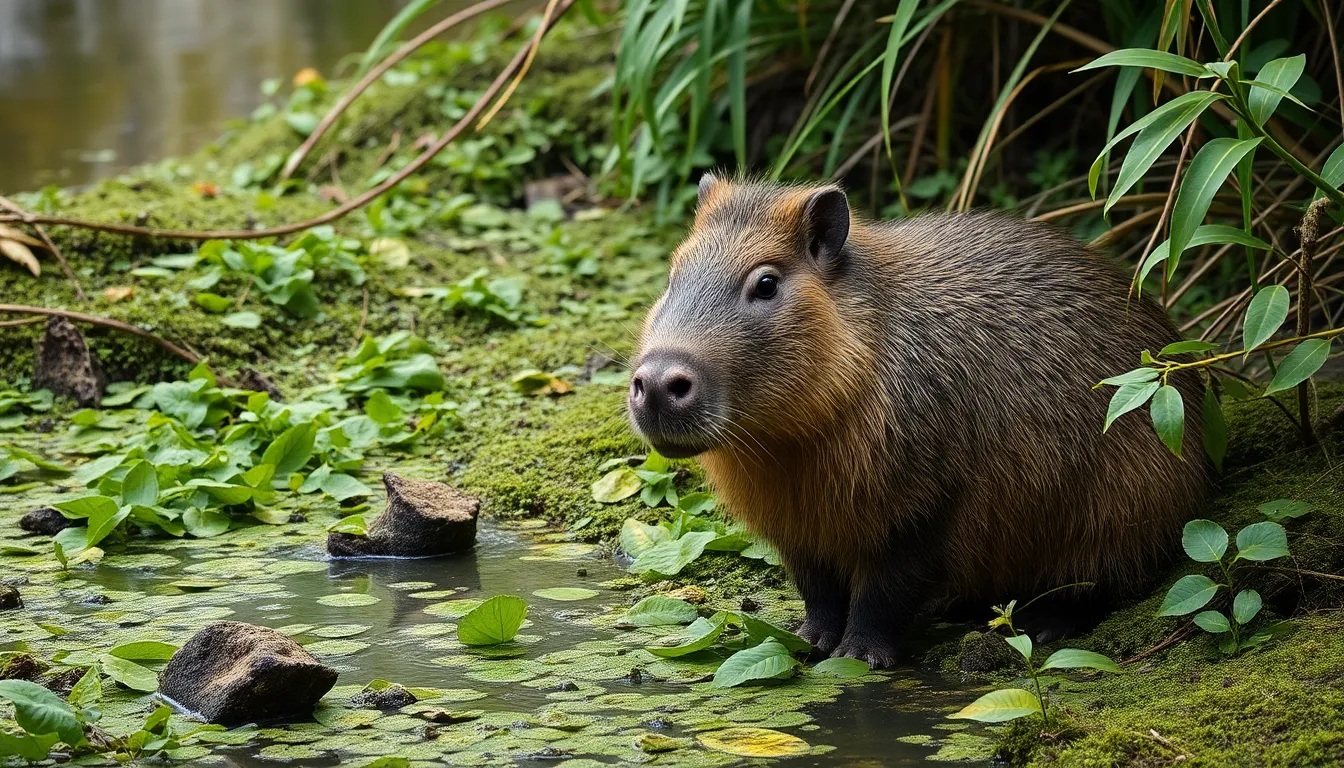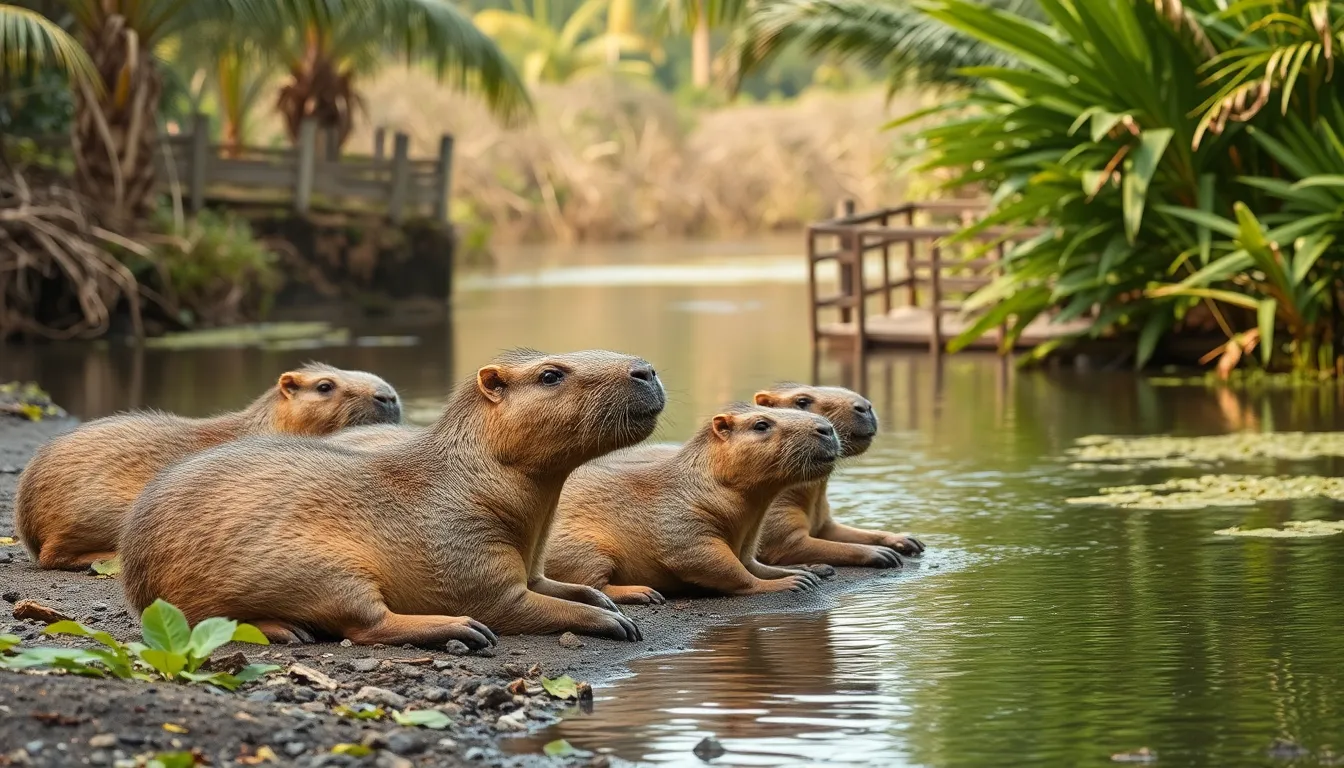Capybaras, the world’s largest rodents, are like nature’s oversized, chill pets that just want to hang out by the water. These friendly creatures are native to South America, thriving in countries like Brazil, Venezuela, and Colombia. If you’ve ever wanted to meet the ultimate socialite of the animal kingdom, look no further!
Table of Contents
ToggleOverview of Capybaras
Capybaras (Hydrochoerus hydrochaeris) represent the largest rodent species, generally weighing between 77 to 146 pounds. These semi-aquatic mammals thrive in the savannas, forests, and wetlands of South America. Brazil, Venezuela, Colombia, and Argentina provide significant habitats for them. Their preference for warm, tropical climates helps them remain active year-round.
Group living characterizes capybara behavior, forming herds that typically comprise 10 to 20 individuals. Social structures within these groups promote bonding and cooperation. Grazing on grasses and aquatic plants serves as their primary diet, demonstrating their herbivorous nature.
Adaptations such as webbed feet enhance their swimming abilities, allowing them to dive and escape predators effectively. Attracting a variety of wildlife, capybaras coexist with caimans, anacondas, and even jaguars. Their friendly demeanor and relaxed attitude endear them to many, making them popular in zoos and wildlife parks.
Breeding occurs throughout the year, with females giving birth to litters of up to eight offspring after a gestation period of approximately five months. Young capybaras typically remain with their mothers for about a year, learning essential survival skills.
Being excellent swimmers, they often submerge themselves in water to regulate their temperature. This ability highlights their specialized adaptations to their native environments. Considering their widespread presence in South America, it becomes clear that capybaras play a vital role in their ecosystems, and their interactions with other species contribute to the overall biodiversity of the regions they inhabit.
Geographic Distribution

Capybaras are predominantly native to the regions of South America and parts of Central America, where they thrive in diverse habitats.
South America
Countries such as Brazil, Venezuela, Colombia, Argentina, Paraguay, and Uruguay serve as primary habitats for capybaras. Brazilian ecosystems, including the Pantanal and Amazon rainforest, offer rich vegetation and abundant water sources. Venezuelan wetlands provide similar resources, promoting large capybara populations. Capybaras prefer warm climates with ample food sources, primarily grasses and aquatic plants. In Argentina, they inhabit areas near rivers, lakes, and marshes, utilizing their social structures for protection. In Paraguay, these rodents coexist with predators, highlighting their important role in local ecosystems.
Central America
Central America has limited populations of capybaras, primarily found in countries like Costa Rica and Panama. These regions feature suitable habitats such as wetlands and riverbanks that support capybara lifestyles. Costa Rica’s rich biodiversity and abundant water resources make it a favorable environment. In Panama, capybaras often inhabit areas close to lakes and mangroves, finding adequate food sources. Limited numbers occur here compared to South America, revealing the geographic concentration of their population. Despite fewer capybaras, their presence in Central America enriches local wildlife networks.
Habitats Preferred by Capybaras
Capybaras thrive in diverse environments that offer ample water sources and vegetation. Various habitats support their social structure and diet, allowing them to flourish across their native regions.
Wetlands and Rivers
Wetlands and rivers serve as prime habitats for capybaras. These areas provide abundant aquatic plants and grasses, essential for their herbivorous diet. In Brazil, the Pantanal features vast wetlands that shelter large capybara populations. Social groups may gather near riverbanks, promoting interaction and bonding among individuals. Predators such as caimans often inhabit these ecosystems, allowing capybaras to develop strategies for coexistence. Additionally, water bodies facilitate cooling during hot days and enhance swimming skills, which act as a defense mechanism. The combination of resources and safety makes wetlands and rivers vital to capybara survival.
Forested Areas
Forested areas complement the habitats of capybaras, particularly along the edges where they interact with open spaces. These forested regions provide cover and shade, important for escaping heat and potential threats. Capybaras often live near the outskirts of forests, utilizing the vegetation for protection while accessing water sources. The Amazon rainforest, rich in biodiversity, supports substantial capybara populations. Enhanced tree cover also creates ideal foraging opportunities for the grasses and plants that capybaras prefer. Social structures thrive in these habitats, where groups can maintain safety in numbers. Overall, forested areas contribute significantly to the adaptability and resilience of capybaras in South America.
Cultural Significance
Capybaras hold a unique place in the cultural landscape of South America. Their friendly nature and sociable behavior endear them to many people.
In Local Folklore
In many South American cultures, capybaras feature prominently in folklore and stories. Legends often personify these creatures, portraying them as symbols of friendship and harmony. In some narratives, capybaras possess wisdom and intelligence, providing guidance to other animals. Their presence is celebrated during local festivals, where traditional foods and activities reflect the community’s appreciation of capybaras. Alongside providing insight into local wildlife, these tales emphasize the capybara’s role as an important cultural icon.
As Pets
Capybaras are increasingly popular as exotic pets in various regions. Many people are drawn to their social and gentle demeanor, making them ideal companions. Owners often describe the bond formed with these rodents as unique, enjoying their playful interactions and calm presence. However, prospective pet owners must consider the specific care requirements capybaras need, such as ample space and access to water. Local laws and regulations often govern their ownership, reinforcing the importance of responsible caregiving. Despite these challenges, capybaras continue to capture the hearts of those who appreciate their amiable nature.
Conservation Status
Capybaras face various conservation challenges in their native regions. Although their population is currently stable, habitat destruction and hunting pose significant threats. Deforestation and wetland drainage directly impact their ecosystems, diminishing available resources.
In specific areas, capybaras benefit from legal protections, but enforcement varies across countries. Brazil’s legislation provides some safeguards in protected areas like the Pantanal. Yet, illegal hunting remains a concern in certain regions.
Their adaptability aids capybaras in surviving habitat changes, but continuous threats undermine their populations. With rapid urbanization in several South American countries, the encroachment on natural habitats increases competition for resources. As agricultural activities expand, capybaras often encounter other wildlife and livestock, leading to conflicts.
Conservation efforts have gained traction in areas where capybaras reside. Various organizations focus on habitat restoration and community education to promote coexistence. Conservation initiatives emphasize the ecological benefits that capybaras provide, such as grazing on grasses and aiding ecosystem balance.
While capybaras maintain a stable population, ongoing conservation efforts are crucial. Habitat protection remains a priority to ensure long-term survival. A balanced approach to agriculture, urban development, and wildlife conservation can help protect these iconic rodents in their natural environments.
Capybaras are more than just the largest rodents in the world; they embody the essence of social harmony in their native South American habitats. Their presence enriches ecosystems and showcases the intricate balance of wildlife interactions. As they continue to thrive in wetlands and forests, the importance of conservation efforts becomes increasingly clear. Protecting their habitats ensures that future generations can appreciate these charming creatures. By fostering understanding and respect for capybaras, communities can work towards a sustainable coexistence that benefits both wildlife and people.





